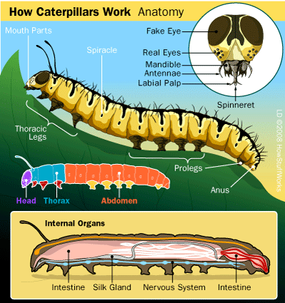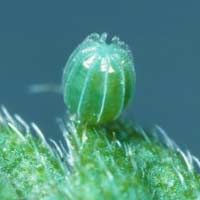Caterpillar Anatomy: A Tube for Food
A caterpillar's life starts with a textured, patterned egg and ends with a chrysalis -- a protective covering in which the caterpillar pupates, or undergoes a metamorphosis. Once the insect leaves the chrysalis, it's a full-grown butterfly or moth. It's the same species as it was before, but it no longer looks much like a caterpillar.
Between egg and chrysalis are a series of molts, in which the caterpillar sheds its too-tight skin, typically eating it afterward. This gives the caterpillar a little extra nourishment and also gets rid of evidence that could attract predators. The stage between each molt is called an instar, and most caterpillars go through five of them, growing very quickly and consuming lots of food to power their metamorphosis. The length of each instar varies based on the caterpillar's species, its food intake and the weather. Molting gives caterpillars more room to move, but it doesn't wipe out what they've learned about their environment -- most likely, their memory lasts over one or two molts.
Advertisement
A caterpillar's body is basically a tube for processing and storing food. A set of mouth parts lets the caterpillar chew its food -- typically leaves and other plant parts. The mouth empties into a very long intestine with fore and hind parts. Here, the caterpillar's digestive system breaks down the food and eventually stores it in a layer of fat called the fat body.

Six legs attached to the thorax let the caterpillar move around. Additional pairs of prolegs support and move the length of the caterpillar's abdomen. These prolegs end in small, hook-like suction cups called crochets. Since prolegs don't have segments or joints, they're not real legs, so even though it doesn't look like it, a caterpillar is a six-legged animal.
Most caterpillars move in one of two ways. Some crawl, moving each pair of prolegs and their true legs in sequence. Others, like the caterpillars of geometer moths, have no prolegs in the middle part of their abdomen. These caterpillars move in little arches, appearing to measure the surface under them.
The rest of the caterpillar's body lets it survive and get around:
- Spiracles are holes in the caterpillar's sides through which it breathes.
- Antennae provide sensory input, particularly relating to taste and smell.
- In many species, false eyes help distract predators while real eyes allow the caterpillar to see.
- Hairs, spines and quills called setae can deter predators and even carry toxins and irritants.
- An osmeterium, found on swallowtail caterpillars, produces a foul-smelling substance that deters predators.
Caterpillars also have spinnerets, or silk-producing organs, in their heads. Next, we'll look at how silk can save a caterpillar's life, why it effects how quickly a caterpillar grows and why it's crucial to a successful metamorphosis.
